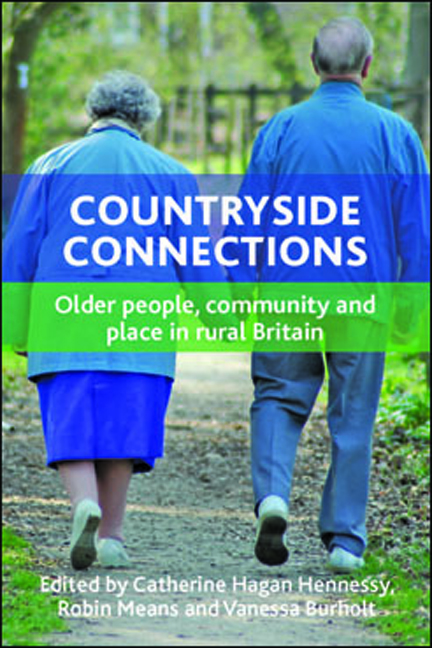Book contents
- Frontmatter
- Contents
- List of tables and figures
- Acknowledgements
- Notes on contributors
- Foreword
- one Countryside connections in later life: setting the scene
- two Conceptualising rural connectivities in later life
- three Rural connectivity and older people’s leisure participation
- four Connecting with community: the nature of belonging among rural elders
- five Beyond transport: understanding the role of mobilities in connecting rural elders in civic society
- six Deep mapping and rural connectivities
- seven Older people, low income and place: making connections in rural Britain
- eight Connecting with older people as project stakeholders: lessons for public participation and engagement in rural research
- nine Towards connectivity in a Grey and Pleasant Land?
- Index
four - Connecting with community: the nature of belonging among rural elders
Published online by Cambridge University Press: 04 March 2022
- Frontmatter
- Contents
- List of tables and figures
- Acknowledgements
- Notes on contributors
- Foreword
- one Countryside connections in later life: setting the scene
- two Conceptualising rural connectivities in later life
- three Rural connectivity and older people’s leisure participation
- four Connecting with community: the nature of belonging among rural elders
- five Beyond transport: understanding the role of mobilities in connecting rural elders in civic society
- six Deep mapping and rural connectivities
- seven Older people, low income and place: making connections in rural Britain
- eight Connecting with older people as project stakeholders: lessons for public participation and engagement in rural research
- nine Towards connectivity in a Grey and Pleasant Land?
- Index
Summary
Place attachment is a particular type of connectivity that could be described as the ‘glue’ that connects people to places. The study of place attachment stems from phenomenology and builds on the philosophical premises concerning the sense of belonging and being-in-the-world. Typically, this approach shies away from reductionist or psychometric approaches to the study of place attachment and uses qualitative data to examine this concept. Although such qualitative approaches provide useful conceptions around place attachment, qualitative data are not readily empirically generalisable. Because a central aim of social gerontology has been to apply research to improve the lives of older persons, this chapter draws on quantitative survey data from the Grey and Pleasant Land (GaPL) project conducted in England and Wales (described in Chapter One) to construct a multidimensional measure of place attachment and to examine how older people develop a connection with their place of residence. In so doing, its aim is to strengthen the empirical research base on place-based connectivity.
In this chapter, we review the literature on place attachment and then empirically test conceptual models based on the literature to identify the predictors of, and the pathways to, place attachment. These analyses contribute to a small body of literature on the place attachment of older rural adults (Rowles, 1988, 1990; Burholt and Naylor, 2005; Burholt, 2006, 2012; Keating et al, 2011), and we reflect on the applicability of our findings to those from Canadian rural communities that formed a parallel project to the UK research.
What is place attachment?
A number of different degrees of connectivity to the community as locale are described in the literature and several authors have considered the multidimensional nature of place attachment. Mohan (2011), for example, notes its heterogeneity: from complete disengagement to full commitment; from activity in some spheres but not in others; and participation at some times but not at others. Scheff (2011) notes its extremes as being ‘complete alienation’ on the one hand and ‘complete solidarity’ on the other – from high levels of social capital to fractured communities. Some people are just happy ‘being’ in a place without necessarily being actively involved in it (Forrest and Kearns, 2001; Hidalgo and Hernandez, 2001), possibly because they do not share common values with others in the community (Gilbert, 1996).
- Type
- Chapter
- Information
- Countryside ConnectionsOlder People, Community and Place in Rural Britain, pp. 95 - 124Publisher: Bristol University PressPrint publication year: 2014
- 1
- Cited by



